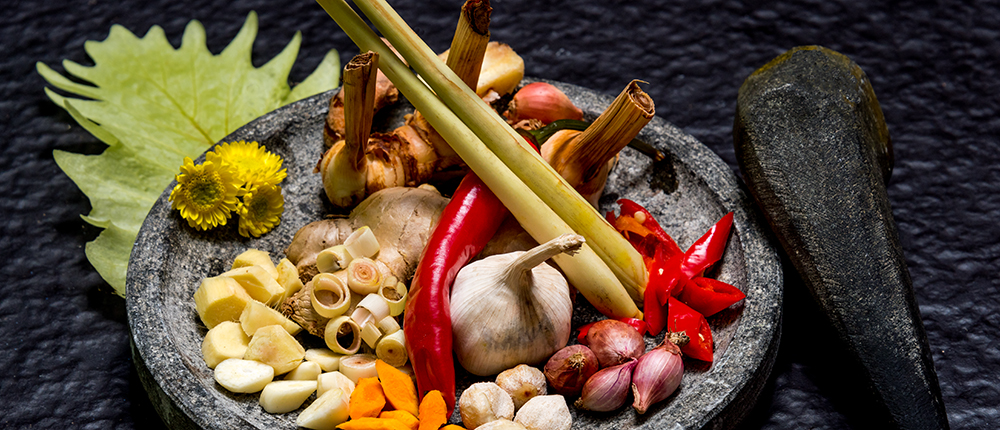Flavors of Wakatobi
An introduction to some of the key ingredients that go into Wakatobi’s signature dishes
Some of the most consistent and frequent compliments we receive from guests at Wakatobi Resort come at mealtime. Each day, our culinary team presents a delicious array of international favorites, regional recipes, and fresh-baked treats. They can handle special dietary requirements and are always more than happy to respond to special requests. From the wide variety of offerings served, the most widely-praised items on the menu are often the kitchen’s signature Indonesian dishes.
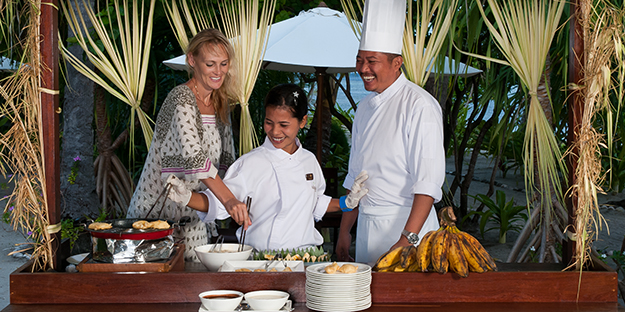
Wakatobi’s culinary team is happy to fulfill any special dietary requirements or requests, and they also like to share many of their techniques during Indonesian cooking demonstrations offered to guests. Photo by Didi Lotze
Typically, there’s nothing special about the basic ingredients that go into our chefs’ regional favorites—rice, fish, meats and fresh vegetables. The magic begins when our chefs add in those special spices and ingredients that infuse the unique and diverse flavors of Indonesia. These are sometimes described as mixtures of tangy, earthy, sweet, sour, spicy, savory and earthy. Or you could just say “delicious.” Whatever the description, there are common ingredients behind many of these flavors, and we’ve asked our chefs to share some of their key herbs and spices.
Essential
Galangal is relative of ginger, and one of the most common cooking spices in Indonesia. It is a key ingredient in most curry pastes, imparting a flavor often described as earthy, sharp, and citrusy. There are actually several related forms of this root used both in cooking as well as various traditional medicines. The go-to variety for many dishes is known as laos or lengkuas. It has ivory white flesh and a mildly-sharp, sweet flavor that doesn’t get lost when combined with other spices. Some dishes call for kencur, which is a type of galangal with a much stronger flavor. In addition to curry pastes, you may encounter finely slivered bits of galangal floating in a bowl of Tom Kha Gai chicken soup; mixing with the flavors of cinnamon, garlic and chili in beef Rendang; or added to a hot-and-sour seafood salad. Ask Wakatobi’s chefs to share a favorite Indonesian recipe, and galangal will likely be on the ingredients list.
Zesty
Indonesia has long been a crossroad of cultures, which is reflected in the diversity of cuisines enjoyed across this nation of islands. One of the elements that ties the region’s disparate dishes together is lemongrass. This fragrant green is prized for its ability to add a touch of zest to most any recipe. According to Chef Wayan, lemongrass adds a wonderful scent, while it’s mildly citrus-like flavor helps mask the fishiness of seafood and the heaviness of red meats, making everything taste cleaner, delicate and more succulent.
“Lemongrass adds a wonderful scent, and makes everything taste cleaner, delicate and more succulent,” says Chef Wayan.
Certain dishes push lemongrass beyond a supporting role and give it primary responsibility for taming dishes that are big on the spices. Two examples that might appear in the Wakatobi restaurant are grilled shrimp accompanied by a fiery lemongrass and chili sambal, and Ayam Sambal Goreng Sereh, which is chicken braised in a light lemongrass sauce.
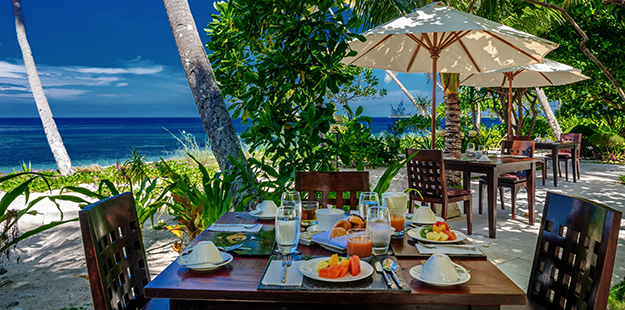
You may find starfruit on the breakfast table at Wakatobi, accompanied by a stunning ocean view. Photo by Didi Lotze
Tart
When sliced crosswise, the fruit of the carmabola tree forms a five-pointed star. Hence the name starfruit. Though native to Southeast Asia, starfruit is now grown in tropical regions around the world, and enjoyed for it’s tangy, citrusy flavor, which wavers somewhere between sweet and sour. The fruit is quite juicy, and can be eaten whole. It is often juiced as a stand-alone drink or as an element of a fruit smoothie. But it also finds its way into the kitchen, where it becomes a key ingredient in a number of sauces and relishes, and sometimes finds its way into stir-frys. You may find starfruit on the breakfast table at Wakatobi, or served for lunch or dinner as part of a fruit salad known as Rujak. The chefs may also whip up a batch of pickled starfruit, or mix it with peppers, garlic and spices to create a sweet-and-sour relish known as Kamrakh.
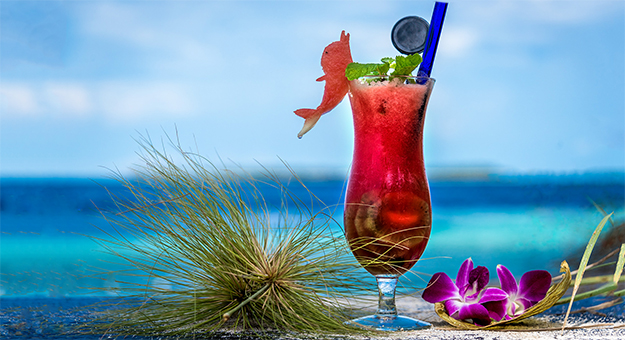
Mocktails created with dragonfruit are particular favorites among Wakatobi guests and staff. Photo by Didi Lotze
Fruity
Dragonfruit grows wild in Indonesia, and is also cultivated. This cactus-like plant bears a semi-sweet, slightly crunchy fruit that is likened to a milder version of a kiwi fruit. The inner white or red flesh and the embedded seeds are edible, and dragonfruit may show up in fruit salads, turned into a syrup, pureed into a jam, or blended into juice beverages. It’s becoming especially popular in non-alcoholic “mocktails,” where it lends both color and flavor to mixtures. At Wakatobi, you might find bright-pink servings of red dragonfruit on the fruit plate, or enjoy a delicious dragonfruit mocktail at the restaurant or Jetty Bar.
Tangy
When reduced to a pulp, the bean-like seedpods of the tamarind tree become the basis for a potent paste that adds a unique tart element to curries and sauces. A little bit of tamarind essence goes a long way, and its unique flavor adds an unmistakable note to any spice mix. Though slightly sour in nature, tamarind is often cut with a pinch of sugar to move it towards sweet. Because it is acidic, tamarind is also used as a tenderizer in marinades, and added to slow-cooked stews to transform meats from chewy chunks into melt-in-your-mouth morsels.
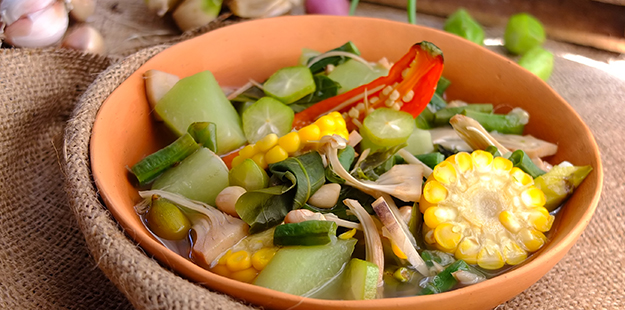
A little bit of tamarind essence goes a long way, and its unique flavor adds an unmistakable note to vegetarian favorites like Sayur Asem. Photo by Wakatobi Resort
Fish may also get the tamarind treatment, and it is a key ingredient in many regional condiments. But you don’t have to be a meat eater to experience the savory nature of tamarind. Make a request for Sayur Asem, and Wakatobi’s chefs will present you with a bowl of delicious vegetable tamarind soup, a favorite with vegetarians.
Colorful
It’s easy to spot a someone who has been chopping up fresh turmeric root, because their fingers will likely be stained a bright yellow. This cloying tint is sometimes used in place saffron to add color and flavor to rice dishes, but there are many other reasons why turmeric is a staple of Indonesian pantries. From a health standpoint, its a powerful antioxidant that becomes a key ingredients in many traditional folk medicines, and it’s also mixed into skin-soothing poultices.
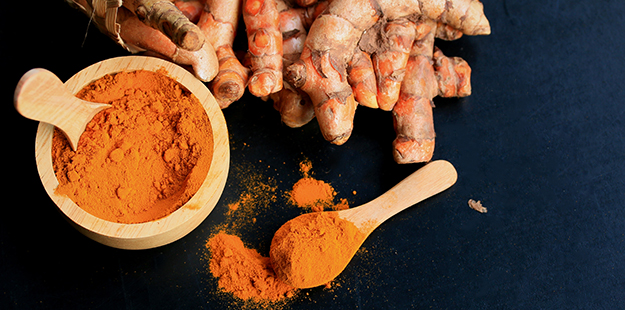
Our chefs use turmeric often for its distinct flavor as well as the striking color it adds to many dishes. Photo by Wakatobi Resort
Cooks value turmeric for its earthy, peppery and mildly bitter flavor, and a fragrance slightly reminiscent of orange and ginger. Turmeric is the key ingredient in one of Indonesia’s favorite comfort foods: Ayam Goreng Kuning. That translates to fried chicken, but this isn’t Colonel Sander’s recipe. Before it goes into the oil, Indonesian-style fried chicken is first marinated and then simmered in a broth of coconut milk, herbs and spices, with turmeric often taking center stage to give a distinctive yellow tinge to the crust. If your tastes run more to fish than fowl, ask Wakatobi’s chefs for a taste of Ikan Bakar, which literally means burned fish. It will arrive at the table perfectly charred, with the flesh infused with a sweet-spicy flavor that includes a hint of turmeric. Add a few dips of sambal badjak or sambal terasi and you are in for a treat.


